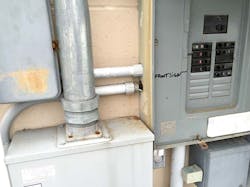What's Wrong Here? Hint: Job has its Shortcomings
How well do you know the Code? Think you can spot violations the original installer either ignored or couldn't identify? Here's your chance to moonlight as an electrical inspector and second-guess someone else's work from the safety of your living room or office. It's your turn to identify the violation.
Hint: This job has its shortcomings.
June Winner
Our only winner this month was Zachary Stoler, a helper electrician and Southern Maine Community College student from Orrs Island, Maine. Stoler knew that this box and these cables were not properly secured.
Nothing in Sec. 314.23(A) through (H) permits the use of tape as the only means for securing boxes. Braces, nails, screws, clamps, anchors, and other fittings identified for the application are some of the approved methods of securing boxes.
In addition, Section 300.11(A) requires boxes to be “securely fastened in place.” I don’t believe electrical tape is a means of secure support for this box. In order to access the wiring inside the box, one would need to unwrap or cut the tape, which would effectively remove the support for the box.
Another problem worth mentioning here is the way in which all of this equipment is secured to the EMT. Section 300.11(B) does not permit you to secure cables or boxes to raceways unless the raceway is specifically identified for this purpose.
Lastly, in accordance with Sec. 330.30(B), MC cable is required to be secured at intervals not exceeding 6 ft; however, some of these cable don’t seemed to be supported at all.
About the Author

Russ LeBlanc
Owner
Russ started in the electrical trade as an apprentice in 1985. He worked his way up to become a Journeyman Electrician and then eventually became a Master Electrician and Licensed Construction Supervisor. In 1999 Russ become an Electrical Instructor for The Peterson School of Engineering in Massachusetts where he developed his passion for teaching, and quickly became Department Head of Electrical Instruction. Russ has taught thousands of apprentices, electricians, engineers, inspectors, and other electrical professionals during his career as an instructor. He continues to provide electrical professionals with Electrical Code seminars, Arc-Flash Awareness training seminars and educational material through his LeBlanc Consulting Services in North Reading, MA whose specialty is educating electricians. He has been an active member of the NFPA Electrical Section and has authored hundreds of National Electrical Code proposals and comments which have become Code rules to improve the safety for the electrical industry. Russ is also an IAEI certified Electrical Inspector.
Please visit www.russleblanc.net for more information.


